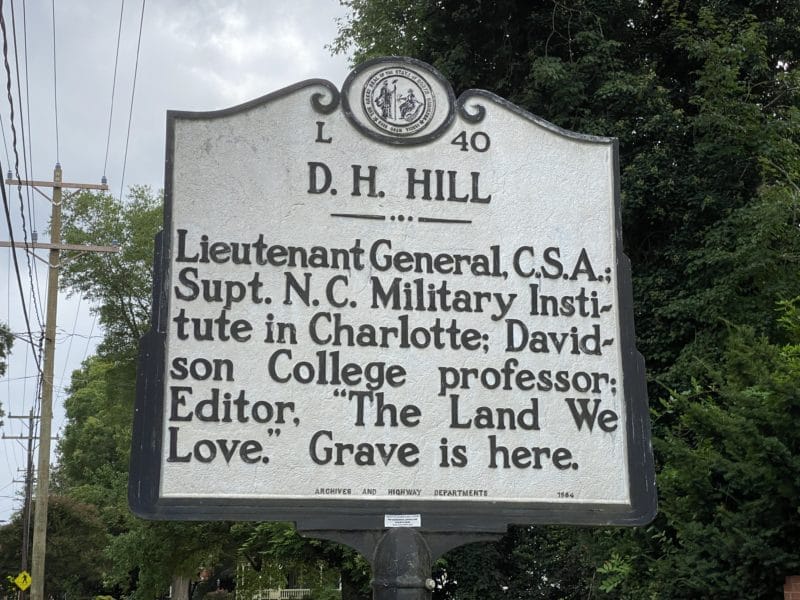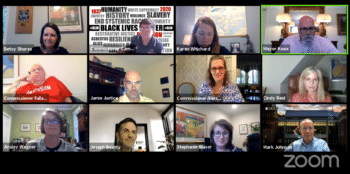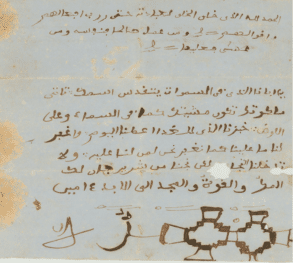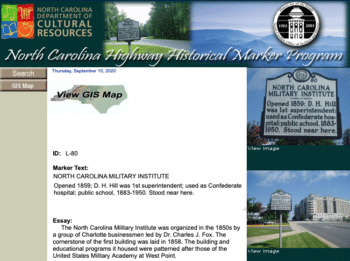NEWS
A Label on Our Landscape?

A North Carolina historical marker for D.H. Hill is located on N. Main Street. It is the oldest of the 3 markers in town.
After questions arose earlier this summer regarding the D.H. Hill Historical Marker located on N. Main Street, Town Board members asked staff to get more information about the sign and the historic marker program.

A screen shot of the virtual Town Board meeting.
Ansley Wegner, Administrator of the N.C. Highway Historical Marker Program, made a presentation at the August 11 Town Board Meeting. She was joined by Joseph Beatty, a member of her staff. The program operates jointly with NCDOT.
A recent local news story provided somewhat confusing information about what was actually discussed at that Town Board meeting. Your News of Davidson team watched the video from the meeting and put together the following information to provide greater detail. That video is available online if you want to watch it, too. Most notably, the discussion was exclusive to the historic marker and did not involve any conversation about Hill’s grave.
Town Board members were joined by Stephanie Glaser and Mark Johnson from Davidson College. All three historical markers in town have direct or indirect connection to the college.
Wegner’s presentation provided a detailed overview of the program. She noted the first marker was placed in 1936, and that the advisory committee that makes the decisions about markers is made up of ten history professors from four-year colleges and universities. They meet twice a year to review applications from the public. She also provided technical details about the signs – notably that they are handmade of cast aluminum at Sewah Studios in Marietta, Ohio.
There are currently 1,618 markers across the state, and you can go to this website to see where each is located. The markers are only located on N.C. state maintained roads, which is why you see some markers that say that the historically significant location is a certain distance and direction away from the marker.
Wegner emphasized that the historic markers are not monuments; calling them “labels on the landscape.” She also noted that they tell the good and bad history of our state, using the example of the “Eugenics Board” as one of those bad parts. Some markers tell the stories that you know, and some that you don’t. Wegner also noted that, at times, the committee has to debate where to place a sign, highlighting that sometimes an individual has connections in several locations in the state.

This is one of the historic documents of Omar Ibn Said (Sayyid) that is in the Davidson College Archives. This is his translation of the Lord’s Prayer into Arabic.
In fact, the example of one such deliberation was for Omar Ibn Said, who had deep connections in Bladen County, Fayetteville, and Wilmington. As she was speaking about Said, Wegner paused and said, “I think some of his diaries are in Davidson.”
Stephanie Glaser, Associate Vice President for Campus and Community Relations, confirmed that his Bible is in the college archives. Additional research shows that in addition to his Bible, there are two other documents in the archives. One is Said’s translation of the Lord’s Prayer into Arabic.
Wegner said that the committee made the decision to locate the marker for Said based on an application submitted by residents of Fayetteville.
Said’s marker reads: “Oman Ibn Said (1770-1863) – Muslim slave and scholar. African-born, he penned autobiography in Arabic. 1831. Lived in Bladen County and worshipped with local Presbyterians.”
Wegner also noted that markers have been updated or removed, based on requests or revelations that the information contained on the marker is inaccurate.
Wegner’s presentation included images of local markers that communities have placed. These markers recognize significant local events that, otherwise, would not qualify for a state marker. These local programs supplement the state-wide effort.
She said that the state does not “double mark” an individual. As such, when people in Bath, NC requested a marker for John Lawson, the committee disapproved it. There is a state marker for him located elsewhere. Residents in Bath opted to dedicate their own marker to Lawson. During the Q&A discussion, Commissioner Autumn Michael asked if Hill were “double marked.” At that time, neither Wegner nor Beatty believed that to be the case.

This screen shot from the North Carolina Highway Historical Marker Program web site that shows a second marker that highlights D.H. Hill.
Conversation at the meeting also included the Davidson College sign, focused on the idea that “there is a lot of room to re-write that.” Wegner said, “There is a story to tell about the college, and it is not about Woodrow Wilson.”
Subsequent to briefing the Davidson Town Board, Ansley Wegner reached out to town staff to say that additional research revealed a second marker recognizing D.H. Hill. The marker for the North Carolina Military Institute on East Morehead Street at South Boulevard singles out Hill as the Institute’s first Superintendent.
The town does not have the authority to remove the D.H. Hill historical marker but can make a request. After receiving the information that Hill is “double marked,” the Town Board made the decision at their August 25 meeting to ask the Mayor to write a letter to the committee (the ten history professors), seeking the removal of the D.H. Hill N.C. Historic Highway Marker. The Board expects the committee to take up the request/application at their next meeting, which is tentatively scheduled for December.
There was also conversation following the presentation about moving forward with a local effort to better tell the history (good and bad) of Davidson. Your News of Davidson team will keep a lookout for this important effort as it moves forward.


